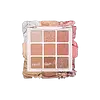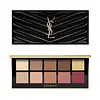Etude House Play Color Eyes 9-Color Versus Yves Saint Laurent Couture Clutch Eyeshadow Palette Desert Nudes
What's inside
What's inside
 Key Ingredients
Key Ingredients

 Benefits
Benefits

 Concerns
Concerns

No concerns
 Ingredients Side-by-side
Ingredients Side-by-side

Mica
Cosmetic ColorantTalc
AbrasiveCI 77891
Cosmetic ColorantDiisostearyl Malate
EmollientDimethicone
EmollientAluminum Starch Octenylsuccinate
AbsorbentBoron Nitride
AbsorbentZinc Stearate
Cosmetic ColorantCI 77491
Cosmetic ColorantOctyldodecyl Stearoyl Stearate
EmollientIsostearic Acid
CleansingWater
Skin ConditioningCI 73360
Cosmetic ColorantCI 75470
Cosmetic ColorantLauroyl Lysine
Skin ConditioningEthylhexylglycerin
Skin ConditioningCaprylyl Glycol
EmollientTin Oxide
AbrasiveTriethoxycaprylylsilane
Calcium Titanium Borosilicate
AbrasiveCalcium Aluminum Borosilicate
Diphenylsiloxy Phenyl Trimethicone
Skin ConditioningPropylene Glycol Dibenzoate
Skin ConditioningPentaerythrityl Tetraisostearate
EmollientMagnesium Myristate
Silica
AbrasiveTrioctyldodecyl Citrate
EmollientDimethicone/Vinyl Dimethicone Crosspolymer
Skin ConditioningHydrogenated Styrene/Methylstyrene/Indene Copolymer
CI 77492
Cosmetic ColorantPentaerythrityl Tetra-Di-T-Butyl Hydroxyhydrocinnamate
AntioxidantCI 19140
Cosmetic ColorantCI 77007
Cosmetic ColorantAluminum Hydroxide
EmollientMethicone
EmollientPolypropylene
Triethylhexanoin
MaskingPentaerythrityl Tetraethylhexanoate
EmollientPCA Dimethicone
Skin ConditioningCI 77499
Cosmetic ColorantBis-Diglyceryl Polyacyladipate-2
EmollientPolyethylene Terephthalate
Polybutylene Terephthalate
Polyglyceryl-2 Triisostearate
EmulsifyingOctyldodecanol
EmollientAcrylates Copolymer
Ethylene/Va Copolymer
Emulsion StabilisingPolyurethane-11
Aluminum PCA
AstringentCI 15850
Cosmetic ColorantMica, Talc, CI 77891, Diisostearyl Malate, Dimethicone, Aluminum Starch Octenylsuccinate, Boron Nitride, Zinc Stearate, CI 77491, Octyldodecyl Stearoyl Stearate, Isostearic Acid, Water, CI 73360, CI 75470, Lauroyl Lysine, Ethylhexylglycerin, Caprylyl Glycol, Tin Oxide, Triethoxycaprylylsilane, Calcium Titanium Borosilicate, Calcium Aluminum Borosilicate, Diphenylsiloxy Phenyl Trimethicone, Propylene Glycol Dibenzoate, Pentaerythrityl Tetraisostearate, Magnesium Myristate, Silica, Trioctyldodecyl Citrate, Dimethicone/Vinyl Dimethicone Crosspolymer, Hydrogenated Styrene/Methylstyrene/Indene Copolymer, CI 77492, Pentaerythrityl Tetra-Di-T-Butyl Hydroxyhydrocinnamate, CI 19140, CI 77007, Aluminum Hydroxide, Methicone, Polypropylene, Triethylhexanoin, Pentaerythrityl Tetraethylhexanoate, PCA Dimethicone, CI 77499, Bis-Diglyceryl Polyacyladipate-2, Polyethylene Terephthalate, Polybutylene Terephthalate, Polyglyceryl-2 Triisostearate, Octyldodecanol, Acrylates Copolymer, Ethylene/Va Copolymer, Polyurethane-11, Aluminum PCA, CI 15850
Talc
AbrasiveSynthetic Fluorphlogopite
CI 77891
Cosmetic ColorantOctyldodecyl Stearoyl Stearate
EmollientPentaerythrityl Tetraisostearate
EmollientAluminum Starch Octenylsuccinate
AbsorbentMagnesium Carbonate
AbsorbentMagnesium Myristate
Diisostearyl Malate
EmollientCI 77492
Cosmetic ColorantStearyl Dimethicone
EmollientCaprylyl Glycol
EmollientDimethicone
EmollientEthylhexylglycerin
Skin ConditioningCaprylic/Capric Triglyceride
MaskingOctadecene
SolventCI 77491
Cosmetic ColorantCI 77499
Cosmetic ColorantPotassium Sorbate
PreservativePentaerythrityl Tetra-Di-T-Butyl Hydroxyhydrocinnamate
AntioxidantCI 75470
Cosmetic ColorantMaltodextrin
AbsorbentPunica Granatum Fruit Extract
AntioxidantTocopherol
AntioxidantTalc, Synthetic Fluorphlogopite, CI 77891, Octyldodecyl Stearoyl Stearate, Pentaerythrityl Tetraisostearate, Aluminum Starch Octenylsuccinate, Magnesium Carbonate, Magnesium Myristate, Diisostearyl Malate, CI 77492, Stearyl Dimethicone, Caprylyl Glycol, Dimethicone, Ethylhexylglycerin, Caprylic/Capric Triglyceride, Octadecene, CI 77491, CI 77499, Potassium Sorbate, Pentaerythrityl Tetra-Di-T-Butyl Hydroxyhydrocinnamate, CI 75470, Maltodextrin, Punica Granatum Fruit Extract, Tocopherol
Ingredients Explained
These ingredients are found in both products.
Ingredients higher up in an ingredient list are typically present in a larger amount.
Aluminum Starch Octenylsuccinate is a synthetic powder used as an absorbent, thickener, and anti-caking agent.
As an absorbent, it is great at mattifying skin by soaking up the oil. This is why you'll find it in a range of products from makeup to moisturizers.
This ingredient is considered a modified starch. Starch can also be found naturally in plants.
One study from 1991 found that 5% of this ingredient enhanced titanium dioxide SPF by as much as 40%. The study found 1% titanium dioxide had a 5.6 SPF and adding 5% of aluminum starch octenylsuccinate boosted it to an SPF of 8.1
Although “aluminum” in an ingredient name can raise red flags for some consumers, the form and usage context matter significantly. For typical topical applications, there is no substantial evidence of health risks - such as cancer, neurotoxicity, or systemic “aluminum overload.”
Learn more about Aluminum Starch OctenylsuccinateCaprylyl Glycol is a humectant and emollient, meaning it attracts and preserves moisture.
It is a common ingredient in many products, especially those designed to hydrate skin. The primary benefits are retaining moisture, skin softening, and promoting a healthy skin barrier.
Though Caprylyl Glycol is an alcohol derived from fatty acids, it is not the kind that can dry out skin.
This ingredient is also used as a preservative to extend the life of products. It has slight antimicrobial properties.
Learn more about Caprylyl GlycolCi 75470 is a bright-red pigment. It is AKA carmine.
Carmine is derived from insects such as the cochineal beetle. This ingredient has been used as a natural dye for over 2000 years.
Ci 77491 is also hydrated iron III oxide. It's sole purpose is to give a red/pink hue to products.
Iron III oxides are classified as inorganic chemicals for coloring.
Synthetically created Ci 77491 is considered safer than those naturally found. This is because the synthetically created version may contain less impurities. Iron oxides are generally non-toxic and non-allergenic.
Learn more about CI 77491Ci 77492 is also hydrated iron III oxide. It's sole purpose is to give a yellow hue to products.
Iron III oxides are classified as inorganic chemicals for coloring.
Synthetically created Ci 77492 is considered safer than those naturally found. This is because the synthetically created version may contain less impurities. Iron oxides are generally non-toxic and non-allergenic.
Learn more about CI 77492Ci 77499 is also hydrated iron III oxide. It is created from mixing red and black iron oxides. This helps give shades of darkness to a product.
Iron III oxides are classified as inorganic chemicals for coloring.
Ci 77891 is a white pigment from Titanium dioxide. It is naturally found in minerals such as rutile and ilmenite.
It's main function is to add a white color to cosmetics. It can also be mixed with other colors to create different shades.
Ci 77891 is commonly found in sunscreens due to its ability to block UV rays.
Learn more about CI 77891Diisostearyl Malate is an emollient and most often used in lip products. It comes from isostearyl alcohol, a fatty acid, and malic acid, an AHA.
As an emollient, Diisostearyl Malate helps create a thin film on your skin to trap moisture in. This helps keep your skin soft and smooth.
Dimethicone is a type of synthetic silicone created from natural materials such as quartz.
What it does:
Dimethicone comes in different viscosities:
Depending on the viscosity, dimethicone has different properties.
Ingredients lists don't always show which type is used, so we recommend reaching out to the brand if you have questions about the viscosity.
This ingredient is unlikely to cause irritation because it does not get absorbed into skin. However, people with silicone allergies should be careful about using this ingredient.
Note: Dimethicone may contribute to pilling. This is because it is not oil or water soluble, so pilling may occur when layered with products. When mixed with heavy oils in a formula, the outcome is also quite greasy.
Learn more about DimethiconeEthylhexylglycerin (we can't pronounce this either) is commonly used as a preservative and skin softener. It is derived from glyceryl.
You might see Ethylhexylglycerin often paired with other preservatives such as phenoxyethanol. Ethylhexylglycerin has been found to increase the effectiveness of these other preservatives.
We don't have a description for Magnesium Myristate yet.
Octyldodecyl Stearoyl Stearate is created from stearic acid.
It is an emollient and thickens the lipid (oil) portion of a product. Due to its emollient properties, it may not be fungal-acne safe.
Pentaerythrityl Tetra-Di-T-Butyl Hydroxyhydrocinnamate (long name, huh?) is a synthetic antioxidant.
It is used to help stabilize other antioxidants or prevent the color from changing in a product.
As an antioxidant, it helps fight free-radical molecules. Free-radical molecules are capable of damaging our cells and other genetic material. Thus, antioxidants may reduce the signs of aging.
This ingredient is oil-soluble.
Learn more about Pentaerythrityl Tetra-Di-T-Butyl HydroxyhydrocinnamatePentaerythrityl Tetraisostearate is derived from isostearic acid. It is an emollient and emulsifier.
The highest concentration of this ingredient is found in lipsticks.
This ingredient is minimally water soluble and may not be Malassezia folliculitis, or fungal-acne safe.
Learn more about Pentaerythrityl TetraisostearateTalc is a clay mineral. It helps absorb moisture and improve the texture of products. Like other types of clay, Talc can have a slight exfoliating effect on skin. Talc can be added to increase the volume of products.
Some Baby powders are made by combining talc with corn starch. The word "talc" comes from Latin and originates from Arabic. Talc is a mineral commonly found throughout the world.
If you have any concerns about using talc, we recommend checking out the FDA's official page.
Learn more about Talc